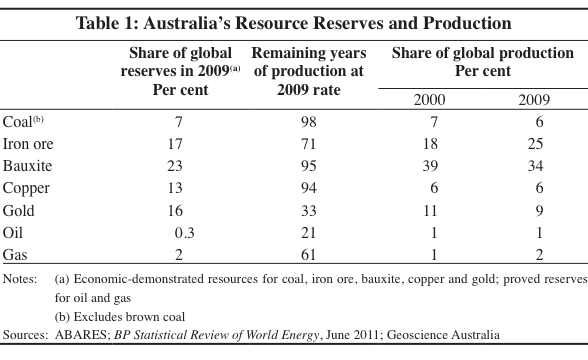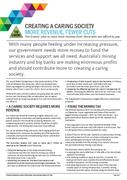(This piece is written on the basis of public statements by the Coalition and Labor. The Coalition and Labor have not yet released policy documents on mining)
Points of difference between the Coalition and Labor
The Coalition proposes to rescind the Minerals Resource Rent Tax (MRRT).
From July 2012, the federal government led by Julia Gillard added a minerals resource rent tax (MRRT) for coal and iron ore, but not for other minerals, at an effective tax rate of 22.5%, and extended the PRRT at a 40% rate to on-shore oil and gas. The MRRT tax base is similar to the PRRT tax base, namely a measure of economic rent assessed as receipts less cash expenses. As a transition measure for existing mines, in the calculation of the MRRT taxable sum, mines were given the option of using the market value of their capital assets (rather than the historical cost), and the market value includes an estimate of the value of the future stream of economic rents.
Importantly, rather than replace the royalty system with an economic rent system of special taxation of the mining industry as recommended by the Henry Review of 2010, the Gillard system retained the state royalties, and it gives a credit for state royalties. In effect, the special taxation of the on-shore mining industry is the maximum of the state royalty and of the MRRT or PRRT. As no surprise, state governments have used this design feature to raise their royalty rates, and to transfer revenue from the federal government to the states.

A combination of the design features of the MRRT to allow firms to use the market value of their assets and for credit to be given for state royalty payments has resulted in a very small revenue collection for the MRRT, of just $200 million in 2012-13. These features, together with projections of much lower mineral prices over coming years as increased global mining output results from the mining investment boom enters the market, suggest only small, if any, MRRT revenue to the federal government under the current system.
To date, the Labor government has proposed no change to the current system of special taxation of the mining industry.
In contrast, the Coalition proposes to rescind the MRRT, and to handle any revenue foregone as a part of its more general budget strategy.
In reality the revenue effects are likely to be minimal, there will be gains in simplicity, and any change would mean one less source of angst for federal-state financial relations.
The Greens propose a number of measures to increase the revenue to be collected from the MRRT. Proposed changes include: raising the tax rate from 22.5% to 40%; extending the MRRT to all minerals; allowing deductions only for the book value rather than market value; and, holding the royalty credit to royalty rates of 2011.
What the Coalition and Labor agree on
The existing general business income taxation system
There is a consensus between Labor and the Coalition to maintain the existing general business income taxation system.
The federal government collects income tax from investments by the funders of corporate investments in mining in the same way as for corporate investments in all other industries. The corporate income tax is levied at a flat rate of 30% on a measure of the return to shareholders who provide equity investment funds.
With the dividend imputation system, corporate income tax serves as a withholding tax, or a pre-paid tax. Resident shareholders effectively pay tax on their dividend income at their individual personal income tax rate, and superannuation funds at a flat 15% rate.
Non-resident shareholders may or may not receive credit for the Australian paid corporate income tax from their home country taxation authority for their dividends.
In the case of resident shareholders, realised capital gains are taxed at a half of the personal income tax rate.
With debt-funded investments in mining, as in other industries, the debt interest is a deductible expense for the corporation in assessing corporate income tax. Debt interest income is taxed at the personal income tax rate of the resident investor. For most non-residents, a 10% Australian withholding tax is collected.
There is no proposal leading into the election by Labor or the Coalition to change the current income taxation arrangements for corporate income, dividends, capital gains, and debt interest income.
State and Territory Royalties
In the case of on-shore minerals and energy, state governments impose a special tax on the mining industry in the form of a royalty. In most cases an ad valorem royalty is levied as a percent of the gross value of sales at the mine head.
The royalty rate varies across the states and across different minerals. For example, the levy rate for gold in Victoria is zero, 7.5% for iron ore in WA, and for Queensland coal the rate varies from 7% for coal valued at up to $100 per tonne, 10% for coal valued between $100 and $150 a tonne, and 15% for coal valued above $150 per tonne. The same royalty rate applies to mines with a very favourable natural resource endowment and low costs of production as it does to less well-endowed mines with higher costs of production.
At this stage there is no proposal to change the royalty system.
The Petroleum Resource Rent Tax
For off-shore oil and gas projects, the federal government imposes the petroleum resource rent tax (PRRT), which is levied at a rate of 40% on a measure of economic rent earned by the natural resource. Economic rent is measured as revenues less outlays on investments in plant and buildings, labour and materials.
No changes are proposed by any of the main parties.
Conclusion
Ultimately, sensible reform to achieve a simple, more efficient and more equitable system of special taxation of the mining industry requires a cooperative conversation between the federal and the state governments. This necessary step seems unlikely during the current federal election campaign.


